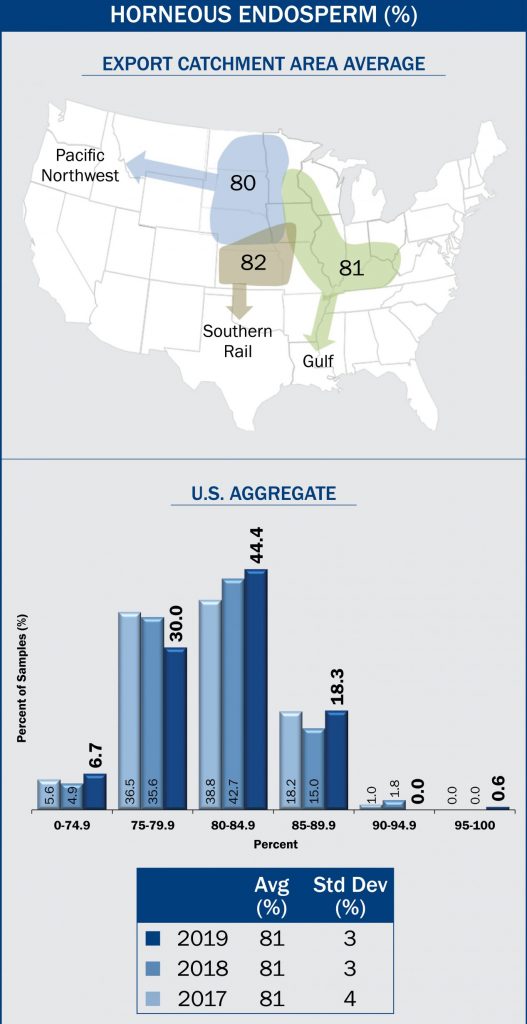Horneous (Hard) Endosperm
The horneous (hard) endosperm test measures the percent of horneous or hard endosperm out of the total endosperm in a kernel, with a potential value from 70 to 100%. The greater the amount of horneous endosperm relative to soft endosperm, the harder the corn kernel is said to be. The degree of hardness is important, depending on the type of processing. A hard kernel is needed to produce high yields of large flaking grits in dry milling. Desired hardness is hard to medium for alkaline cooking, and desired hardness is medium to soft for wet milling and livestock feeding. Hardness correlated to breakage susceptibility, feed utilization/efficiency and starch digestibility.
As a test of overall hardness, there is no good or bad value for horneous endosperm. There is only a preference by different end-users for particular ranges. Many dry millers and alkaline cookers would like greater than 85% horneous endosperm, while wet millers and feeders would typically like values from 70 to 85%. However, there are certainly exceptions in user preference.
Beginning with the 2019/2020 Harvest Report, only the samples tested for the mycotoxin would be tested for horneous endosperm. This quality factor’s relative margin of error had never exceeded 0.4% in the samples tested from the eight previous reports when all samples were tested for this quality factor. Thus, reducing the number of samples tested for horneous endosperm would likely keep the precision of this quality factor’s estimates well below the targeted level of ±10.0%. See the “Survey and Statistical Analysis Methods” section for more information regarding the relative margin of error calculations for the quality factors.
Results
 Average U.S. Aggregate horneous endosperm in 2019 (81%) was the same as 2018 and 2017 (both 81%) and higher than the 5YA (80%).
Average U.S. Aggregate horneous endosperm in 2019 (81%) was the same as 2018 and 2017 (both 81%) and higher than the 5YA (80%).- U.S. Aggregate standard deviation for horneous endosperm was 3% in 2019 and 2018, but lower than in 2017 and the 5YA (both 4%).
- The 2019 horneous endosperm range (71 to 96%) was similar to 2018 (72 to 92%) and 2017 (71 to 92%).
- Of the 2019 samples, 63.3% contained more than 80% horneous endosperm, which was a higher percentage than in 2018 (59.5%) and 2017 (58.0%). This indicates 2019 had more kernels with hard endosperm than the two previous years.
- Average horneous endosperm for the Gulf, Pacific Northwest and Southern Rail ECAs was 81, 80 and 82%, respectively. The Southern Rail ECA has had the highest or tied for the highest average horneous endosperm in 2019, 2018, 2017 and 5YA among all ECAs.

